LYNDEN — Heather Koon-Swanson guided a dark bay mule named Ruth to turn on command at the farm where the North Cascades National Park pack string spends winters.
The newest member of the storied stock program followed the direction of the petite woman from Kendall, who led the string for two decades until retiring in December.
Koon-Swanson, 59, spoke softly but firmly to the youngest of nine equines, who were about to get their hooves trimmed by Ferndale farrier Derek Hinde.
She came to the farm on a frigid February morning to volunteer with the pack because officials had yet to fill her position, highlighting the far-reaching impact of the Trump Administration’s dismantling of the federal bureaucracy.
Koon-Swanson had hoped to facilitate a seamless transition this year by leaving the stock program with well-trained animals and a knowledgeable seasonal packer ready to take over.
But …
“Right now, we’re in such a state of limbo it’s hard to really know what’s going to happen,” said Patrick Dingle, a trails crew lead who joined Koon-Swanson at the 40-acre farm near the Canadian border.
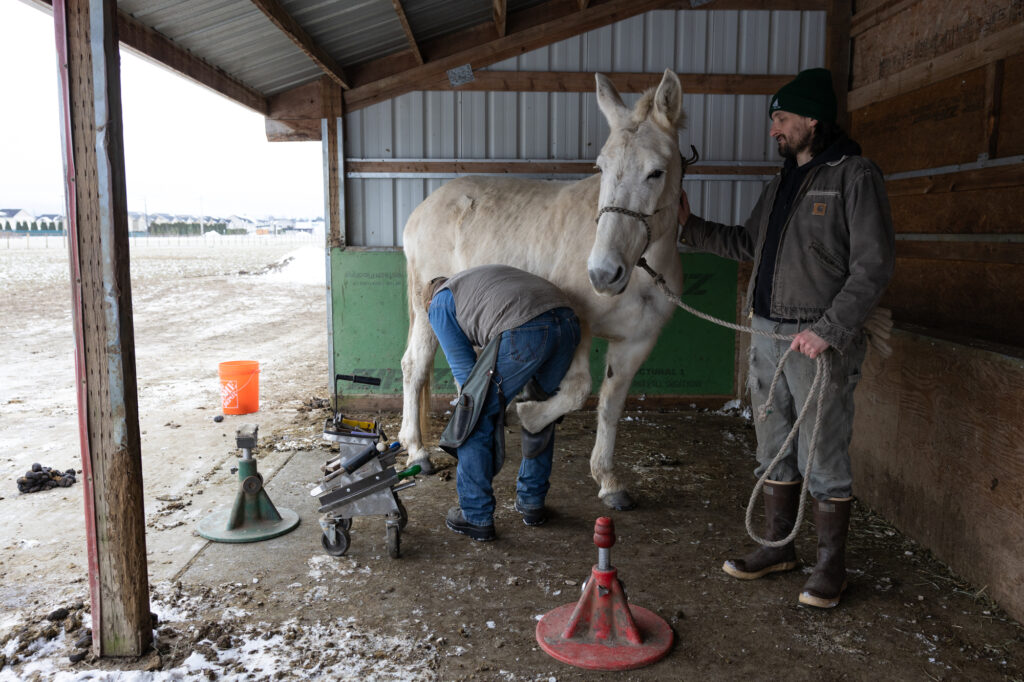
North Cascades is one of about a dozen national parks, including Olympic, that depend on pack animals to cart heavy loads into the backcountry. These fixtures of pioneering history have been pivotal to maintaining 400 miles of North Cascades’ trails in some of the steepest and most rugged topography in the contiguous United States.
“They can go anywhere,” Koon-Swanson said of her string. “They can climb over old-growth logs and go up steep hillsides and cross white water. Not every mule can do what they do.”
The mule-and-horse teams also assist in search-and-rescue missions, firefighting and scientific research.
About half of North Cascades’ 40,000 visitors in 2023 were backcountry campers according to the latest available park service figures.
Without a stock program, the North Cascades interior could become dangerous and inaccessible to the public. Without regular upkeep, trails could suffer permanent damage because of fallen logs and clogged culverts and drainages.
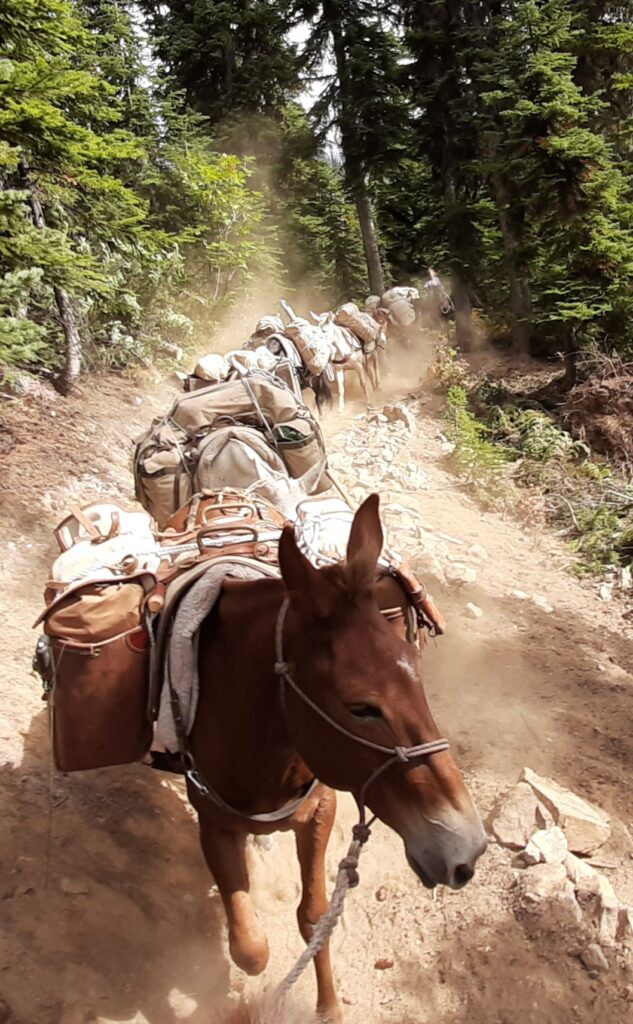
Koon-Swanson spent her final year teaching colleagues the nuances of the stock program. Dingle, who attended a riding camp with the packer, said it could take a team to make it work this year — if they can hire seasonal help.
Whatever happens, which seemingly changes by the day, Koon-Swanson is determined to safeguard the legacy of the pack.
“I’m not just going to let that herd languish, and our crew wouldn’t either,” she said. “I’m going to take care of those animals no matter what.”
Following in historical footsteps
Mules are hybrids of male donkeys and female horses who generally live 30 to 40 years and can work into their 20s, Koon-Swanson said.
The North Cascades string ranges in age from Ruth, 7, to Buddy, 17. They weigh from 850 pounds to 1,400 pounds and comprise every breed, color and gender. Stock programs prefer mules because they possess the best qualities of each parent, making them superior to horses for packing.
Koon-Swanson built a string with different ages and capabilities to make them more interchangeable.
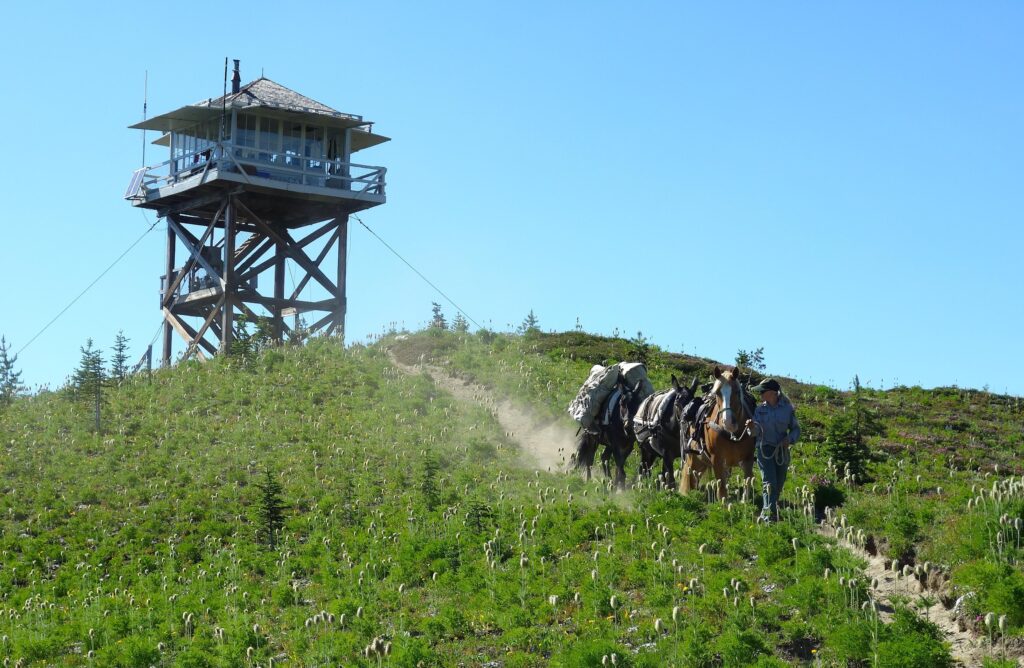
Stewards of North Cascades National Park need a versatile team to help maintain backcountry access. They face difficult challenges because 94% of the park’s 505,000 acres are designated as wilderness. The 1964 Wilderness Act restricts using motorized equipment, making the pack string anything but a relic of the past.
Bill Zimmer, chief of facilities, said in a presentation that the national park boasts 11 major bridges, 30 other significant trail bridges, 150 footlogs and the Chilliwack River cable car. It also has several thousand linear feet of puncheon bridges, three major front-country boardwalks, 100 backcountry camps and a handful of national historic register structures along a network of 65 trails.
The sites and structures endure punishing winters that demand annual maintenance. Work begins in late March and lasts into late November.
The four-legged porters schlep items like batteries, paddle rafts, snares, bait, herbicides, bear boxes, greenhouse plants, erosion control materials, survey equipment, hoses, pumps and fuel for fire suppression. They also retrieve teams of exhausted smokejumpers, rappellers and injured hikers.
Koon-Swanson said the Marblemount-based string averaged 20 multi-day trips and 11 single-day trips per season in the past two decades. Some seasons she has spent 100 nights in the backcountry.
“Our days were 14 to 16 hours long and we never had time to sniff the flowers, so to speak,” said Artie Olson, the park’s one-time trail crew chief.
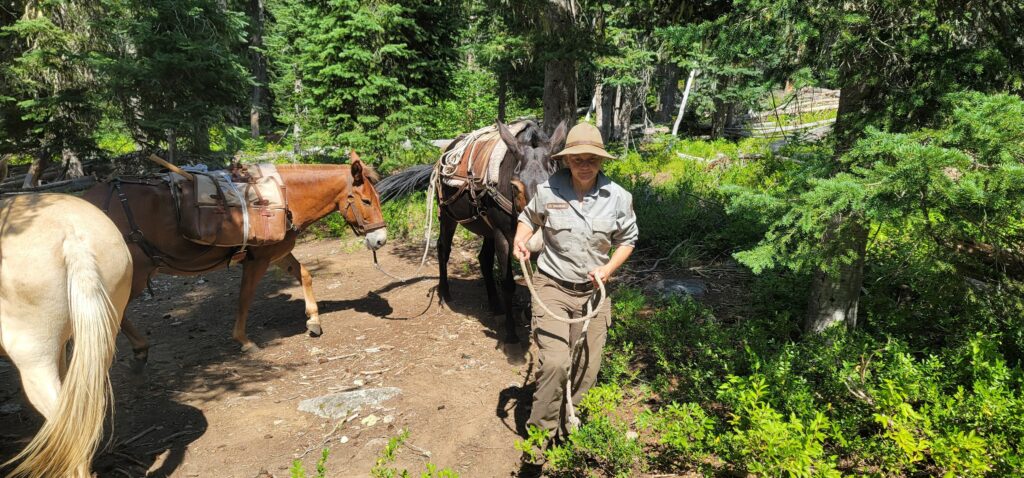
Koon-Swanson usually rode atop Badger to lead her teams, whose numbers depended on the loads they needed to transport.
Her work didn’t end when reaching a work camp.
“Then you start watering, feeding … it’s nonstop,” said Scott Swenson, the park’s maintenance crew chief.
Koon-Swanson often had to deal with the famous Pacific Northwest rainfall that soaked the riding gear and manties, or heavy canvas tarps. She had to dry out the gear as best she could and oil it — and often tacked up the animals in the rain to continue a trek.
The packer worked just as hard when off the trail caring for the animals at their barn in Marblemount. Trail crews work eight days on and six days off during the summer.
Koon-Swanson stayed in Marblemount when on duty because packers are on call in case of emergencies. She got to know the ticks of each animal by hanging around the herd.
“When one farts, I know who it is,” she said. “When one snorts, I know who it is. If someone’s pawing, I know if it’s the one that’s going to paw its leg open.”
Park rangers employ helicopters to fly human waste out and drop off new pit toilets. Almost everything else is ferried by humans or mules.

A 2024 estimate showed helicopters spent $8.60 a pound to transport cargo compared to $2.34 per pound for a pack string, Koon-Swanson said. It costs $3,500 annually to take care of each animal. The investment speaks directly to the park service’s mission of preserving the land and its historical resources for future generations.
“And there’s no more historical structure than a trail,” Koon-Swanson said.
The ancient footpaths crisscrossing the range have remained fundamentally unchanged over the eons.
“Where we think is a good place to put a trail has always been a good place to put a trail,” said Koon-Swanson, adding that some of the park’s camps are located on top of archaeological sites.
“If humans don’t have access to that landscape that brought forth their cultures, then they’re kind of lost,” she said.
Becoming a permanent packer
In the other Washington, the firing of federal employees has been hailed by some as an overdue measure to rein in the budget. But the decisions have overlooked the people and animals who make visiting national parks a favorite American pastime.
Koon-Swanson “embodies what it is to be an employee in a remote park,” said Dana Barton, North Cascades historic preservation specialist.
Koon-Swanson, a Western Washington University alumna, is a former Mount Baker climbing ranger, trail worker, explosives expert, helicopter manager, heavy equipment operator, commercial big truck driver, advanced paraglider and revered packer.
The packer likes to say she grew up on a “hillbilly stump farm” in Joyce, Clallam County, where the family raised cows, horses and pigs. She was reared on cowboy movies and Zane Grey novels and got a Shetland pony for her sixth birthday.
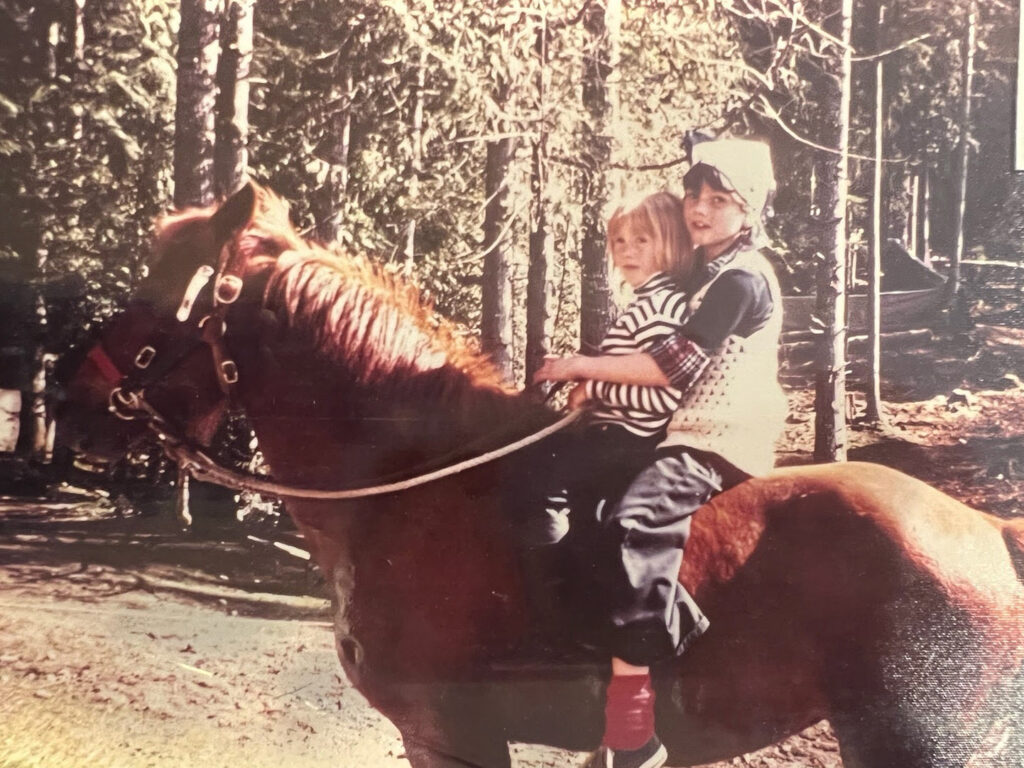
“I’ve done a lot of different things over the years, but I feel like my entire life was preparing me to be a packer,” Koon-Swanson said.
In the 1980s, she worked seasonal jobs for the U.S. Forest Service while attending the University of Puget Sound and later Western, where she earned a degree in environmental science.
Koon-Swanson continued doing trail work and other jobs for the Forest Service after college. In 1996, she switched to North Cascades National Park as a trail worker with hopes of becoming a permanent packer.
When the park’s first packer, Jane Burnett-Ziolkowski, left in 2002, Olson didn’t have to search far for a replacement.
The 5-foot-3 Koon-Swanson was one of the top members of his crew, and had been mentored by Burnett-Ziolkowski on how to handle the herd.
“There was nothing that we could do that she couldn’t do — and a lot of times, do it better,” Olson said.
The trail worker got her dream job in 2003.
‘Heather at home on the farm’
One day, Koon-Swanson greeted me at her Kendall homestead wearing blue jeans, a black Eddie Bauer puff vest and a flannel shirt.
A winter freeze had hardened the yard, where her lead packhorse Badger stood eying me. Badger’s blaze was as white as Koon-Swanson’s hair, which she tied into a ponytail.
The packer has cared for Badger, 21, and the mule Bill, 26, in Kendall since they retired this year.
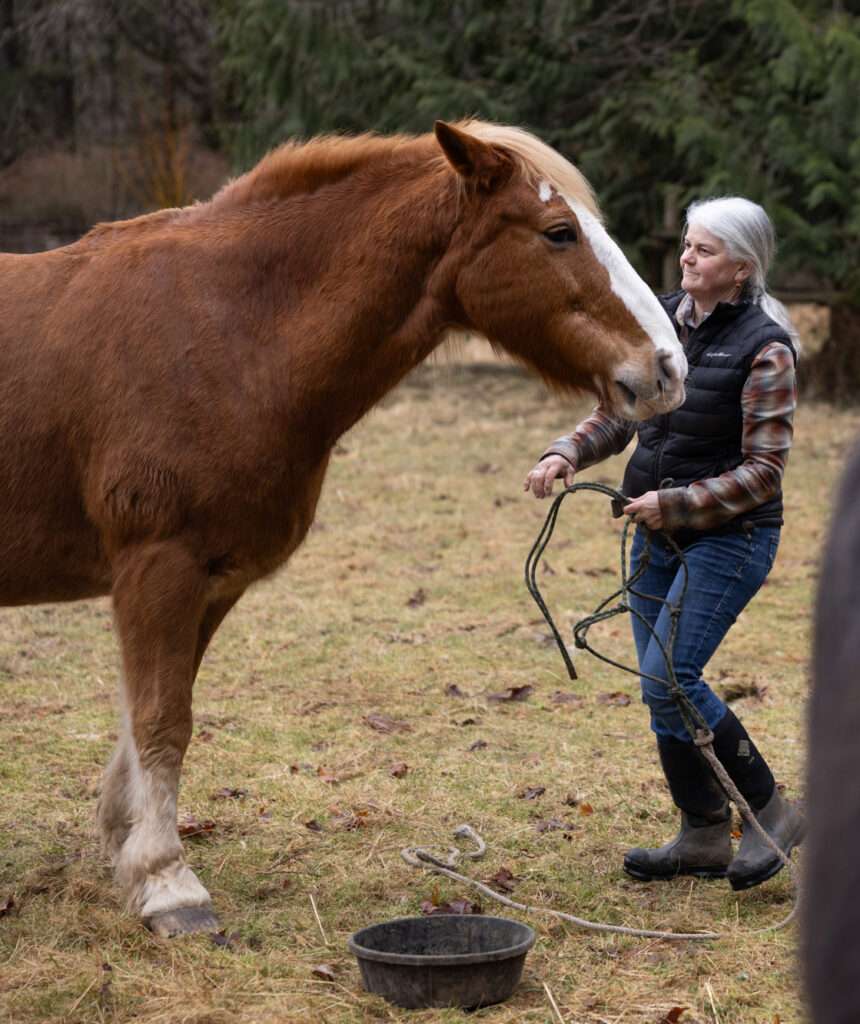
The North Cascades string is down from 12 animals to nine because another member, Josephine, died in November from colic. For now, the three animals are not being replaced — like Koon-Swanson.
On their homestead, her late husband, Leif Swanson, had handled the landscaping at their place tucked against the Cascadian foothills.
Swanson died in 2021 in a paragliding accident in Utah. He was 61.
Like his wife, Swanson was adept in the outdoors. He had worked as a wildland firefighter, logger, trail builder and certified arborist. The couple, who met in 1986, climbed mountains and flew paragliders.
“Leif was my everything person,” Koon-Swanson said. “I could never have done my job away from home all those years if he wasn’t coming home at night to take care of this place and to take care of me too.”
Before his death, the couple had lost eight close friends and co-workers over seven years. Besides illnesses, some died from accidents while driving, paragliding and sailing. A mountain bike accident eventually led to another death.
Leif’s death influenced her decision to leave the park service early to stay home to maintain the spread she built with Leif.
“All of sudden, I am not a wife, I’m not a pilot, I’m not a packer,” Koon-Swanson said. “I realize how all those things contributed to my self-worth. I’m just Heather at home on the farm.”
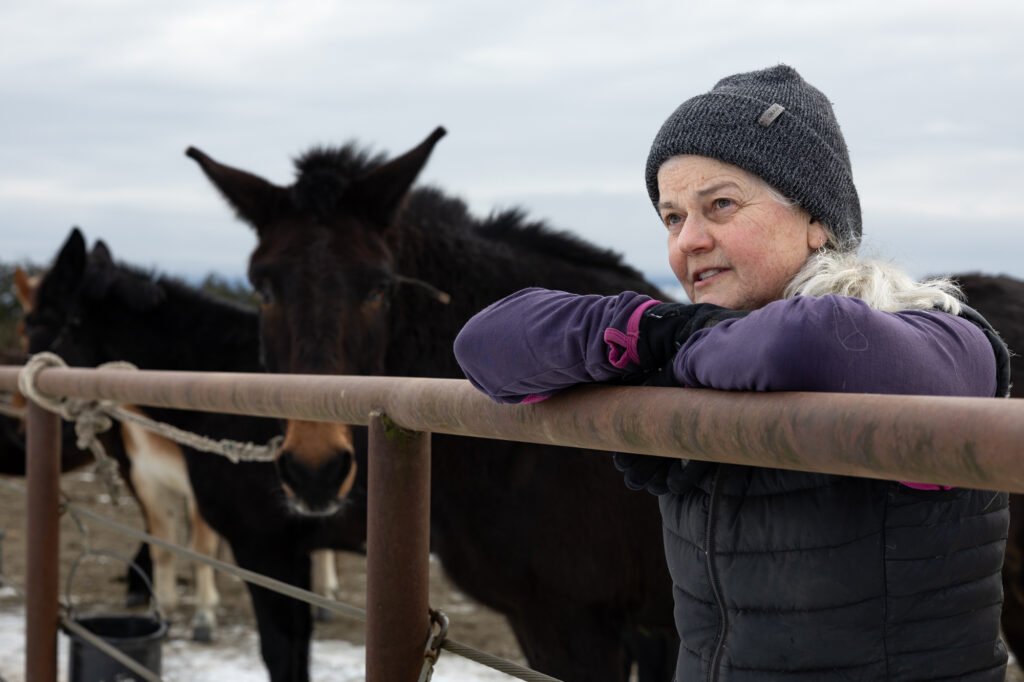
Hope maintenance
Perhaps not to the animals who have spent their lives in the wild with Koon-Swanson. Having Badger and Bill around has helped with the transition because whatever else is happening they need daily care.
Koon-Swanson recalled their exploits while feeding Badger treats.
As a packhorse, Badger would stop the herd from thundering past when she took potty breaks. He’d instinctually stop when a piece of trail gave way or to calm a skittish mule refusing to cross a bridge.
“He’ll stop at just the right moment or speed up if I ask him to because he understands even three, four or five or eight mules back what’s going on,” she said.
At the Lynden farm a few days later, Koon-Swanson moved among the herd to inspect each animal.
“She’s got a real mule whisperer/horse whisperer personality,” said friend Jim Henterly, a renowned national park fire watcher from Deming.
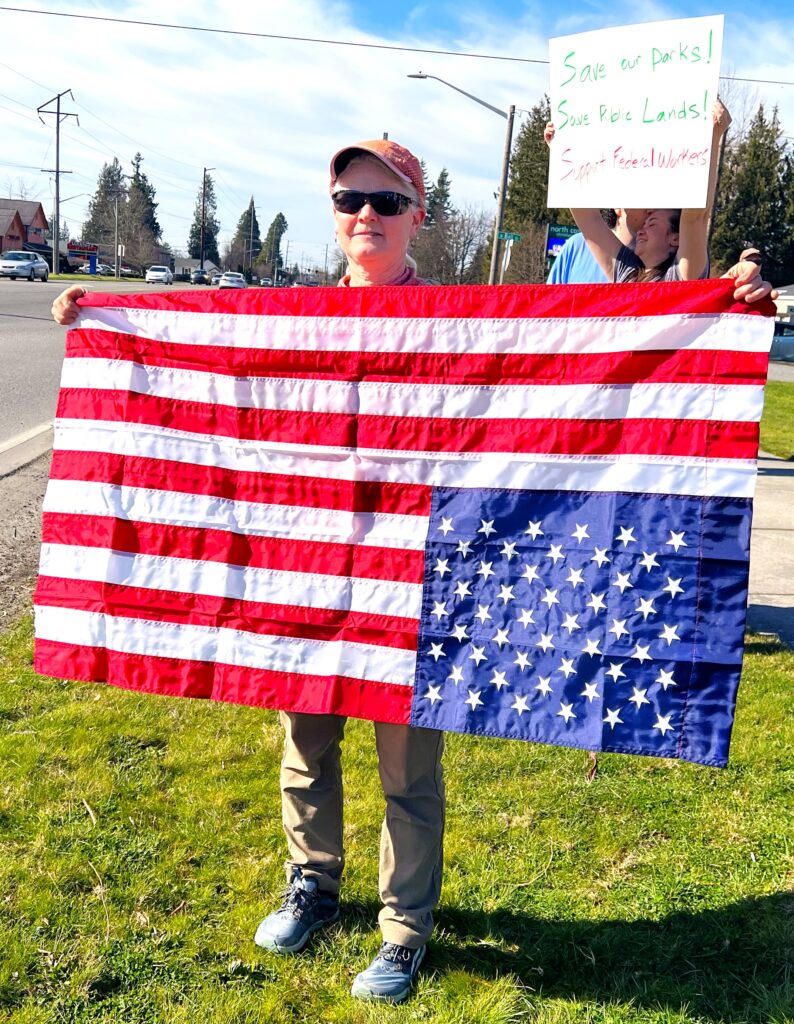
But now Koon-Swanson worries her retirement means North Cascades might not have a packer ever again.
“If we were to eliminate our program, North Cascades National Park most likely will never get it back,” she said.
The situation led her to join about 200 demonstrators at a rally in Sedro-Woolley on March 1 to protest the Trump Administration’s attempt to gut National Park Service funding.
She waved an upside-down American flag along State Route 20 as passersby honked in support.
But not a man in the drive-through line at Timber Espresso a few feet from the rally, who shouted expletives at her.
About an hour later, an encouraging sign in the form of a bald eagle soared above the demonstrators.
The site of a great American symbol at just that moment brought hope to the protesters.
Perhaps Koon-Swanson’s beloved stock program could be saved after all.
Elliott Almond's outdoor column appears monthly. Email: elliottalmond4@gmail.com.




